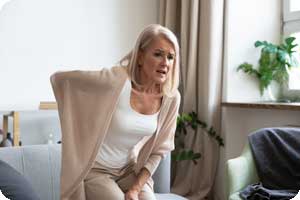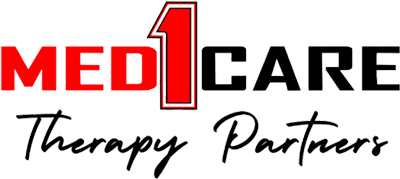 Med1Care Therapy Partner’s Osteoporosis Program combats severe bone thinning from cartilage wear and tear to prevent fractures in the hip and spine, health problems and impaired mobility.
Med1Care Therapy Partner’s Osteoporosis Program combats severe bone thinning from cartilage wear and tear to prevent fractures in the hip and spine, health problems and impaired mobility.
Bones constantly renew themselves in a process called modeling.Bone density usually peaks by the age of thirty, but there are several ways to reduce bone loss with medications and lifestyle choices.
Bone loss is largely hidden until the loss becomes severe. Symptoms of osteoporosis can include:
- Back pain
- Loss of height
- Stooped posture
- Broken bones, typically spine or hip
Severe osteoporosis can even precipitate fractures from daily activities such as coughing, standing, sitting and hugging.
Read more about osteoporosis here.
Risk Factors For Osteoprosis
Risk factors for osteoporosis include several you can control and a few that are unchangeable.
Unchangeable risk factors for osteoporosis include:
- Being female
- Being of white or Asian descent
- Aging
- Having a family member with osteoporosis or a parent who fractured a hip
- Having a small body frame
Risk factors that can be managed include:
- Lowered sex hormones, including falling estrogen levels at menopause or reduced testosterone levels in men being treated for prostate cancer
- Elevated thyroid hormones from an overactive thyroid or taking too much thyroid medication for the treatment of an underactive thyroid
- Overactive parathyroid and adrenal glands
- Low calcium intake
- Calorie-restricted diets
- Gastrointestinal surgery that limits nutrient absorption
- Long-term use of oral or injected corticosteroid medications like prednisone and cortisone, as well as medications used in the treatment of seizures, gastric reflux, cancer and transplant rejection
- Medical conditions like celiac disease, inflammatory bowel disease, kidney or liver disease, cancer, multiple myeloma and rheumatoid arthritis
Lifestyle choices also dramatically affect the likelihood of developing osteoporosis. The disease dis-proportionally impacts those with a sedentary lifecycle and those who are frequent consumers of alcohol or tobacco.
How We Can Help
Med1Care Therapy Partner’s Osteoporosis Program can help you prevent the progression of bone loss and strengthen your bones.
Need a licensed physical therapist in Findlay, Toledo, or any of the 26 counties we service? The therapist will evaluate your need for services, draft a plan and set a schedule that is dedicated to helping you reach your objectives. We will work with your primary care provider to help reduce your pain, avoid more serious complications and improve your quality of life.
Call us at 419.866.0555 to schedule a consultation.
Our specialists will help you chart a course forward.
Bone density usually peaks by the age of thirty. Here are several ways to strengthen your bones:
- Eat calcium-rich foods throughout the day for the highest absorption of this primary mineral. Read more about calcium rich foods
- Load up on green and yellow vegetables which are high in vitamin C and decrease bone turnover.
- Prioritize strength training and weight-bearing exercise to increase bone mineral density, bone strength and size.
- Consume an appropriate level of protein. Low protein intake decreases calcium absorption.
- Eat foods rich in Omega-3 fatty acids, with a 4:1 ratio of omega-6 to omega-3 acids.
- Make sure your Magnesium, Zinc, Vitamin D and K levels are robust.
- Stay away from very low-calorie diets (under 1200 calories) that slow your metabolism and reduce muscle mass and bone density.
- Consider taking collagen which may have beneficial effects on bone health.
- Maintain a healthy weight. Low body weight is the primary contributor to reduced bone density and bone loss in postmenopausal women.
Read more about this list here.
Many people with osteoporosis worry that exercise will increase the risk of a fracture. However, safe exercise is needed because strong muscles protect bones. Ask your physical therapist what exercises are appropriate for you.
Activities generally recommended for people with osteoporosis include:
- Strength training, particularly for the upper back
- Weight-bearing aerobics like walking, dancing, elliptical training, stair climbing, gardening and low impact aerobics
- Flexibility exercises
- Stability and balance training
While swimming and cycling have many benefits, they don’t provide the weight-bearing load bones need to reduce mineral loss.
Activities you should avoid if you have osteoporosis include:
- High-impact exercises like running, jumping and jogging
- Rapid and jerky exercises
- Bending and twisting at the waist, which can cause spinal compression fractures. Avoid toe touches, sit-ups, golf, tennis, bowling and some yoga
